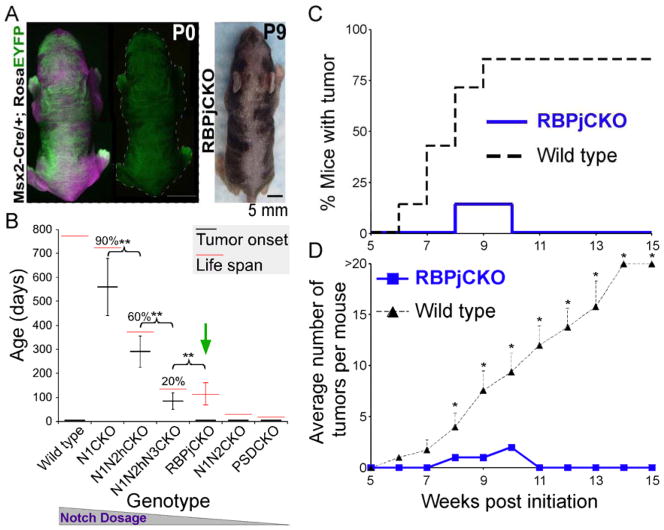Figure 1.
Mice lacking RBPj in portions of their epidermis are resistant to skin tumorigenesis. (A) The calico pattern of EYFP expression (green) induced by Msx2-Cre-mediated gene deletion in a Msx2-Cretg/+; Rosa (LoxP_Stop_LoxP)-Eyfp (Msx2-Cre/+; RosaEYFP) newborn is shown. Image taken under tungsten illumination is shown in magenta. After birth, mutant clones become evident due to hair phenotypes. (B) Reduction in Notch signaling dosage in the skin correlates with shortening of life span and time to spontaneous tumor formation. This trend, however, does not extend to mice lacking RBPj (green arrow), which live ~100 days yet do not develop any skin tumors. n > 20 in each group; % indicates the percentage of mice that developed skin tumors; **: p <0.01, student’s t-test; error bars represent +/− SD. This figure is modified from (Demehri et al., 2009b). (C,D) Time to tumor onset (C; p <0.0001, log-rank test) and average tumor number (D) of RBPjCKO and wild-type littermates treated with the standard DMBA-TPA protocol from 3 to 18 weeks of age are shown. n = 7 for each group; *: p <0.05, student’s t-test; error bars represent +/− SEM. Genotypes: Msx2-Cretg/+; Notch1flox/flox (N1CKO), Msx2-Cretg/+; Notch1flox/flox; Notch2flox/+ (N1N2hCKO), Msx2-Cretg/+; Notch1flox/flox; Notch2flox/+; Notch3−/− (N1N2hN3CKO), Msx2-Cretg/+; Notch1flox/flox; Notch2flox/flox (N1N2CKO), Msx2-Cretg/+; Ps1flox/flox; Ps2−/− (PSDCKO), Msx2-Cretg/+; Rbpjflox/flox (RBPjCKO).

